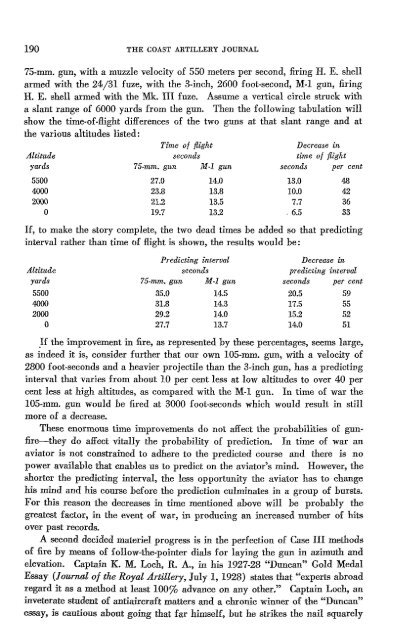THE COAST ARTILLERY JOURNAL - Air Defense Artillery
THE COAST ARTILLERY JOURNAL - Air Defense Artillery
THE COAST ARTILLERY JOURNAL - Air Defense Artillery
You also want an ePaper? Increase the reach of your titles
YUMPU automatically turns print PDFs into web optimized ePapers that Google loves.
190 <strong>THE</strong> <strong>COAST</strong> <strong>ARTILLERY</strong> <strong>JOURNAL</strong><br />
7S-mm. gun, with a muzzle velocity of 550 meters per second, firing H. E. shell<br />
armed with the 24/31 fuze, with the 3-inch, 2600 foot-second, M-1 gun, firing<br />
H. E. shell armed with the Mk. III fuze. Assume a vertical circle struck with<br />
a slant range of 6000 yards from the gun. Then the following tabulation wiII<br />
show the time-of-flight differences of the two guns at that slant range and at<br />
the various altitudes listed:<br />
Altitude<br />
yards<br />
5500<br />
4000<br />
2000<br />
o<br />
Time of flight<br />
seconds<br />
75-mm. gun M-l gun<br />
27.0<br />
23.8<br />
21.2<br />
19.7<br />
14.0<br />
13.8<br />
13.5<br />
13.2<br />
Decrease in<br />
time of flight<br />
seconds per cent<br />
13.0<br />
10.0<br />
7.7<br />
.6.5<br />
If, to make the story complete, the two dead times be added so that predicting<br />
interval rather than time of flight is shown, the results would be:<br />
Altitude<br />
yards<br />
5500<br />
4000<br />
2000<br />
o<br />
Predicting interval<br />
seconds<br />
75-mm. gun M-l gun<br />
35.0 14.5<br />
31.8 14.3<br />
29.2 14.0<br />
27.7 13.7<br />
48<br />
42<br />
36<br />
33<br />
Decrease in<br />
predicting interval<br />
seconds per cent<br />
20.5 59<br />
17.5 55<br />
15.2 52<br />
14.0 51<br />
.If the improvement in fire, as represented by these percentages, seems large,<br />
as indeed it is, consider further that our own IOS-mm. gun, with a velocity of<br />
2800 foot-seconds and a heavier projectile than the 3-inch gun, has a predicting<br />
interval that varies from about 10 per cent less at low altitudes to over 40 per<br />
cent less at high altitudes, as compared with the M-l gun. In time of war the<br />
IOS-mm. gun would be fired at 3000 foot-seconds which would result in still<br />
more of a decrease.<br />
These enormous time improvements do not affect the probabilities of gunfire-they<br />
do affect vitally the probability of prediction. In time of war an<br />
aviator is not constrained to adhere to the predicted course and there is no<br />
power available that enables us to predict on the aviator's mind. However, the<br />
shorter the predicting interval, the less opportunity the aviator has to change<br />
his mind and his course before the prediction culminates in a group of bursts.<br />
For this reason the decreases in time mentioned above wiII be probably the<br />
greatest factor, in the event of war, in producing an increased number of hits<br />
over past records.<br />
A second decided materiel progress is in the perfection of Case III methods<br />
of fire by means of follow-the-pointer dials for laying the gun in azimuth and<br />
elevation. Captain K. M. Loch, R. A., in his 1927-28 "Duncan" Gold Medal<br />
Essay (Journal of the Royal <strong>Artillery</strong>, July 1, 1928) states that "experts abroad<br />
regard it as a method at least 100% advance on any other." Captain Loch, an<br />
inveterate student of antiaircraft matters and a chronic winner of the "Duncan"<br />
essay, is cautious about going that far himself, but he strikes the nail squarely
















